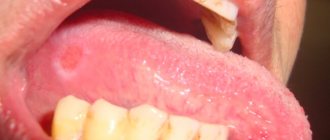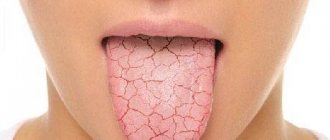White coating on the tongue is usually perceived as a symptom of the disease. A person, as a rule, does not consider his language. In order for us to stand in front of the mirror, stick out our tongue and begin to look at it, there must be some reason that prompted us to do so - discomfort in the throat or oral cavity or some other dissatisfaction with our health. And then we discover a white coating on the tongue (or, as they sometimes say, that our tongue is coated ). However, don't be scared right away. Even a healthy person can have a white coating on the tongue. On the other hand, plaque on the tongue can indeed be a manifestation of the disease. Therefore, it is useful to know how pathological plaque on the tongue differs from plaque, which is considered a variant of the physiological norm.
Physiological white coating on the tongue
White coating on the tongue is most often found in the morning. At night, less saliva is produced, which contributes to the activation of bacterial activity. As a result, by morning, almost all people develop a white coating on their tongue. Sometimes it is accompanied by bad breath.
As a rule, such plaque is easily removed during morning oral hygiene. When we brush our teeth, it is advisable to also brush our tongue, especially its root. Modern toothbrushes have a surface specially modified for this purpose (the other side in relation to the bristles).
However, the white coating disappears on its own as the day begins. It is erased when eating, and the greater amount of saliva released prevents it from forming again.
Deep type
Glossitis, as in the photo, affects the entire surface and thickness of the tongue. The photo shows that the disease has affected the root and frenulum.
In the deep form, the tongue is completely affected
It is characterized by the formation of ulcers, deterioration of the patient’s condition, and throbbing, sharp pain. The tongue swells, which makes speech difficult, and the process of chewing and swallowing food, as well as breathing, is disrupted. If treatment is not started, a person will develop an abscess or phlegmon, spreading to the surrounding tissues up to the cervical areas.
Pathological plaque on the tongue
If the white coating on the tongue is caused by an illness, it persists throughout the day. A thin white coating occurs with any ARVI. It disappears as soon as the patient recovers.
Particular attention should be paid to the compaction of plaque. The body of the tongue is not visible through the thick coating. Such plaque is difficult to remove. Thick plaque is considered a sign indicating the severity of the disease.
The color of the coating on the tongue is also important. The more intense the color, the more serious the pathology that caused the plaque. The color of plaque is not only white. A yellowish tint to the plaque may be associated with a malfunction of the gallbladder or pancreas. Gray plaque is possible in case of stomach disease - gastritis, peptic ulcer. In some severe infectious diseases, plaque may acquire a black, bluish or greenish tint.
However, it should be taken into account that the color of plaque can be affected by smoking, drinking and eating.
Surface type
In general, the disease can affect different areas of the mucous membrane, but the superficial variety affects only its upper layer. Superficial glossitis of the tongue can be seen in the photo.
The photo shows superficial glossitis of the tongue
It all starts small - the catarrhal stage of the disease. First, the mucous membrane becomes swollen, and upon visual inspection it is noticeable that it is covered with a dense coating. If treatment is not started during this period or the pathology is not completely cured, then an ulcerative form develops - small painful aphthae appear on the mucous membrane, which can bleed.
What is glossitis of the tongue? This is a disease that, like many other dental pathologies, can occur in acute and chronic stages. It can have pronounced symptoms or a sluggish inflammatory process that will go unnoticed for a long time, undermining your health. That is why it is so important to undergo timely preventive examinations with a dentist and therapist.
Diseases that cause plaque on the tongue:
- stomatitis;
- thrush (candidiasis). Caused by fungi of the genus Candida. The disease can be caused by long-term use of antibiotics or decreased immunity. With oral candidiasis, a typical manifestation is a dense milky-white coating that covers the tongue in spots. Similar spots may also appear on the roof of the mouth or gums. In severe cases, plaque covers the entire tongue as well as the walls of the throat, making swallowing and breathing difficult.
- scarlet fever. In the first days of the disease, the tongue is covered with a white-gray coating. Then the coating disappears, and the tongue acquires a crimson color;
- whooping cough. A pale yellowish coating on the tongue may be accompanied by bad breath;
- dysentery. A thick white coating is typical;
- cholera. Characterized by a dark coating (even black);
- diphtheria;
- gastritis;
- stomach ulcer;
- enterocolitis;
- pancreatitis;
- stomach cancer;
- kidney diseases;
- some other diseases.
Is glossitis contagious?
It comes as a surprise to many people that the disease can actually be contagious. Here you need to understand that if glossitis of the tongue occurs due to non-infectious causes, for example, mechanical injuries and burns, then it is not contagious. If the cause of its development is infections, viruses and bacteria, for example, staphylococcus, streptococcus, herpes virus or candida fungi, then the pathology can become dangerous not only for you, but also for others and family members.
In addition, glossitis on the tongue may indicate that you have problems in the body, which again can be contagious to outsiders: diphtheria, helminthic infestations, tonsillitis, scarlet fever, syphilis.
Notice
: Undefined variable: post_id in
/home/c/ch75405/public_html/wp-content/themes/UltraSmile/single-item.php
on line
45 Notice
: Undefined variable: full in
/home/c/ch75405/public_html/wp-content /themes/UltraSmile/single-item.php
on line
46
Rate this article:
( 10 ratings, average: 4.90 out of 5)
language
- E.V. Borovsky, A.L., Mashkilleyson M. Diseases of the mucous membrane of the oral cavity and lips, 1984.
Consulting specialist
Dzagurova Elina Ruslanovna
Doctor rating: 9.5 out of 10 (2) Specialization: Dentist-therapist Experience: 10 years
When and which doctor to contact about a coating on the tongue
As a rule, tongue coating is not the main symptom.
And it is other symptoms that tell you which doctor you should see. If plaque on the tongue is accompanied by symptoms of ARVI, you should consult a physician. If you have symptoms of gastrointestinal diseases, contact a gastroenterologist. If there are no such symptoms, and the cause of your concern is plaque, in case of white plaque you can consult a dentist, in case of yellowish or gray plaque, you can consult a gastroenterologist. And in any case, you can consult a general practitioner - family doctor or therapist. A child with a persistent coating on the tongue should be shown to a pediatrician.
What does the tongue say about our health?
The tongue is often called the mirror of our body. Any disturbances in the body are reflected on the surface of the tongue. An external examination of your tongue can tell you whether you are getting enough nutrients and whether you have any digestive problems. Tongue color and texture are important indicators of health problems.
Stand in front of a mirror, open your mouth and stick out your tongue. If it is pink in color with a rough surface, then you are absolutely healthy. With age, the human body ages and health becomes worse, which is reflected in the language. The tongue is an indicator of human health; the state of the tongue can determine the problems occurring in our body.
What does the color of the tongue say?
- Burgundy - infectious diseases
- Pale - heart problems, poor diet
- Yellow - problems with the gastrointestinal tract
- Purple – diseases of the respiratory system
- Gray - indicates the accumulation of bacteria in the grooves of the taste buds
- Black - indicates weakness of the liver and spleen, dysentery, serious viral infections and even abscesses
- Blue - indicates kidney disease
- White is a sign of oral candidiasis, a fungal infection in the mouth
- Bluish - indicates poor blood circulation, scurvy and heavy metal poisoning, especially mercury
- Brown - indicates bleeding in the mouth.
What does the color of plaque on the tongue indicate?
- White plaque is the most common phenomenon in our language. It can be of different nature, it can cover the entire tongue, or it can be located in islands. A light white coating is present on the tongue of a healthy person. Various degrees and forms of white plaque indicate the penetration of infection into the body. As the disease spreads and intensifies, the white coating will gradually thicken and acquire darker shades.
- A yellow tint indicates diseases of the gastrointestinal tract or liver. The rule also applies here - the lighter the plaque, the earlier the stage of the disease. Light yellowness of the plaque in hot weather is considered normal.
- Gray or black plaque - formed as a result of darkening of the white plaque during an exacerbation of the disease or as a result of a chronic disease. The transformation of gray plaque into black will indicate a critical stage of the disease.
- Brown plaque indicates severe or chronic gastrointestinal diseases, as well as lung diseases.
- Greenish-brown plaque - occurs as a result of excess bile in the body against the background of problems with the liver or gallbladder.
- Purple plaque indicates blood stagnation.
- A bluish coating appears with diseases such as dysentery or typhoid.
Signs of internal organs on the tongue.
Traditional Chinese medicine associates certain areas of the tongue with various internal organs. Therefore, disturbances in the functioning of any organ may manifest themselves in the language area associated with this organ. The front of the tongue is a mirror image of the liver, heart and lungs, the middle shows the stomach, pancreas and spleen. Sections of the intestine can be diagnosed by the root of the tongue, but the kidneys can be diagnosed by the lateral sections of the tongue. Various changes in the ulcer, redness of plaque in these projections, indicate one or another pathology of the corresponding organ.
- The tip of the tongue is the heart
Persistent redness close to the tip of the tongue may indicate heart problems. Also, a tongue with a red tip can be a sign of emotional trauma.
- Central part of the tongue - stomach, spleen
A yellow coating on the central part of the tongue indicates problems with digestion, and that there may be something wrong with the stomach, pancreas or spleen.
- Sides of the tongue - liver
The appearance of teeth marks on the sides of the tongue is interpreted as a sign of poor nutrient absorption and may indicate liver problems such as liver enlargement or hepatitis. Bluish-greenish spots on the sides of the tongue can also reflect liver diseases such as cirrhosis.
- The area behind the tip of the tongue is the respiratory system
Red spots on the area of the tongue just behind the tip may indicate lung problems such as pneumonia and asthma. A foam on the front of the tongue can be a sign of congestion in the chest and lungs, and indicate bronchitis and respiratory allergies.
- Back of the tongue – kidneys, intestines
A thick yellow coating on the back (at the base of the tongue) indicates bladder problems and susceptibility to kidney stones and even kidney failure.
All of the above signals from our body for the presence of various diseases require immediate attention to specialists. And one more thing - you need to examine the tongue when it is clean. It can be tidied up with a special tongue massager, which is sold in a pharmacy, or with a soft toothbrush.










